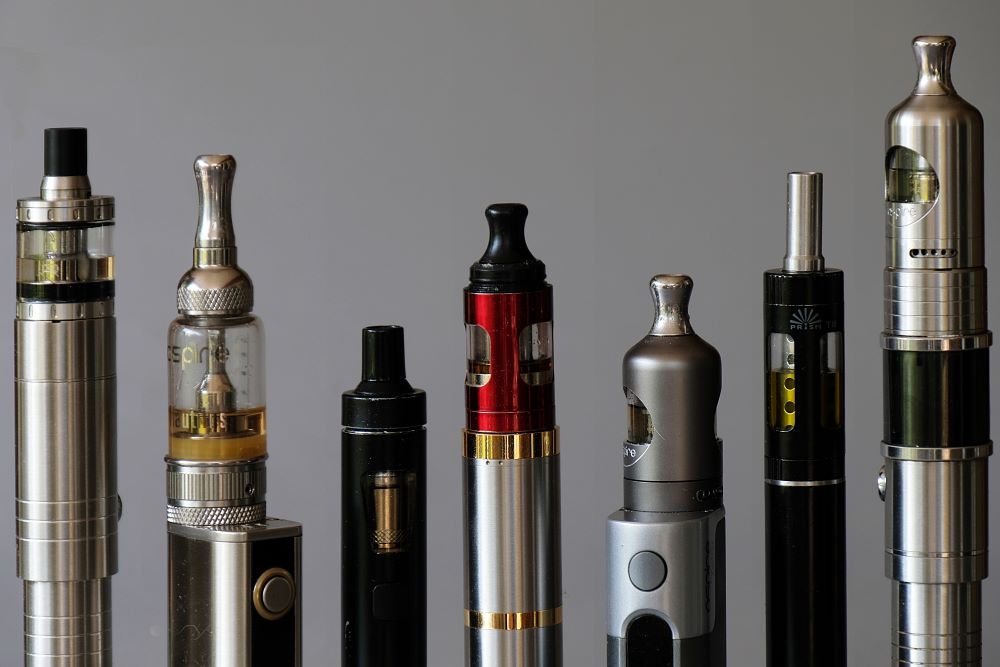Choosing Wisely
- Also in TR Cheryl Olson Print Edition
- November 1, 2022
- 0
- 13 minutes read

Photo: manovankohr

Are choices key to successful switching?
By Cheryl K. Olson and Willie McKinney
Like many people who smoke, Doug Halterman wanted to quit. “I tried other ways, even prescription drugs, and nothing worked.” When he decided to try vaping, “At first, it was a research and development stage. I had to figure out what ones best acted like a cigarette,” he recalled. “I started with menthol tobacco. I then liked the fruit flavors because it helped stay clear of cigarettes. After vaping fruity flavors, cigs tasted absolutely disgusting.”
Halterman’s story of switching is one of several dozen generously shared via emails from members of the Consumer Advocates for Smoke-free Alternatives Association (CASAA). This exploration of what drives change was triggered by anecdotes and research suggesting that encountering and trialing a range of alternative nicotine products, or rotating among an engaging mix of options, can be key to ditching smoking. The typical successful quitting journey seems less like a thruway and more like a meandering river. The U.S. Food and Drug Administration’s Center for Tobacco Products’ approach to researching switching, described in its Final Rule guidance, assumes simple choices and straight lines.
The Wrong Framework?
Premarket tobacco product application (PMTA) behavior studies are supposed to describe likely changes (and related health risks) created by the marketing of a single novel tobacco product of a particular flavor and nicotine strength. This is not unlike studies the FDA’s Center for Drug Evaluation and Research (CDER) reviews, comparing effects of a new drug to a placebo on particular symptoms or endpoints.
In a September 2021 PMTA Technical Review Summary available online, the FDA laid out a new standard that flavored electronic nicotine-delivery system (ENDS) products must meet. Balancing concerns about youth uptake demands “acceptably strong evidence that the flavored products have an added benefit relative to that of tobacco-flavored ENDS in facilitating smokers completely switching away from or significantly reducing their smoking.” What kind of evidence? “Most likely product specific evidence from a randomized controlled trial (RCT) or longitudinal cohort study.”
Again, it’s like testing whether a medicine to treat gout or acne is superior to the current standard therapy, except it casts tobacco flavoring (the taste of cigarettes) as the standard and mango or vanilla as the unproven alternative.
Does an approach that may work for “safe and effective” prescribed drug authorizations make as much sense for a balance-of-risks consumer product standard? Does the CDER mindset serve well the end goal of moving people off combustibles? This pharma-influenced standard may be the wrong tool to address tobacco product effects.
Comments from people’s real-world switching experiences (see sidebar) suggest that a test-in-isolation model fails to capture a lot of key information that could accelerate the move away from smoking and its unacceptably high risks of disease and death.
Unlike pharmaceuticals and devices approved by other FDA centers, nicotine consumer products are not prescribed as a course of treatment. Tobacco users looking to switch aren’t making comparisons among two (or three) options. They meander through shops and gas stations, picking up nicotine products at will and whim. Many use multiple products to suit situations or prevent boredom. They learn through trial and error: How does this product work? What does it do for me? How does it fit into my life? And they choose again.
Another problem: As Neil McKeganey of the Center for Substance Use Research pointed out recently, it’s not clear by how much the FDA values youth vaping prevention over adult smoking cessation. How obviously better would a flavored product need to be at helping smokers switch, compared to a tobacco flavor, to offset concerns about youth appeal? The recent longitudinal study of Juul, where over half of participants switched completely from cigarettes at one year, found that what flavor smokers chose did not significantly affect success.
Missing Variables
Most studies aren’t designed to address the power of choices. Even large surveys that support the importance of flavors in switching tend to collapse flavors into categories (like “sweet” for fruit and candy) and ask about main flavor used, obscuring the paths taken by individual quitters. But there are tantalizing hints. For example, a six-week switching study of tobacco-free pouches found a link between trying more flavors and fewer daily cigarettes smoked. A 2018 study of MarkTen found that smokers who switched completely used more flavors.
Based on her experience researching oral and vapor product behaviors (including MarkTen), “Most smokers don’t successfully switch and sustain their switching through one product category,” said Jessica Zdinak, chief research officer at Applied Research and Analysis Consulting. She notes that academic studies of smoker transitions often leave out important variables, such as previous quitting experiences or stressful changes in life circumstances.
Adding Real-World Evidence
FDA Commissioner Robert Califf has been quoted repeatedly as supporting greater reliance on real-world evidence to support drug regulation decisions. During his first stint as FDA head, Califf said at the 2016 Food and Drug Law Institute conference that “In the past, so-called ‘regulatory trials’ tended to focus on high-quality studies with detailed study procedures, restrictive inclusion and exclusion criteria and have been conducted in special study sites.” By contrast, he noted that “pragmatic clinical trials,” studies that look at treatments and outcomes in actual medical practice settings, “may be the most important source of knowledge in the future.”
Another difference from pharmaceutical products: Many alternative nicotine products have been on the market for several years. Why not consider real-life evidence, as in natural choice situations over time, for tobacco product switching behavior? Don’t throw away tried-and-tested tools but see how they fit in a new context.
Zdinak would like to see long-term randomized trials that incorporate this approach, showing the effect of having or lacking a range of options. To demonstrate the effects of flavors on switching, “What does the world look like if I’m a smoker of 30 years who enters a vape shop, and I have tobacco-flavored vapes as my sole option? Or what happens if I see citrus, mango, cinnamon, coffee and caramel?” She is currently in the design and review phase for one such realistic study.
To quote prominent researchers Dorothy Hatsukami and Dana Carroll, “Most in the tobacco control community would agree that an immediate main goal is to rapidly eliminate tobacco-related death and disease.” If regulators agree, let’s look at what obstacles are preventing smokers from switching more rapidly. That includes tailoring methods and assumptions borrowed from pharma research to suit appropriate for the protection of public health (APPH) standards and goals.
The Power of Choices: Stories from CASAA
Founded in 2009, the Consumer Advocates for Smoke-free Alternatives Association (CASAA) is a 501(c)(4) consumer nonprofit organization that aims to “ensure the availability of a variety of effective, affordable reduced-harm alternatives to smoking.”
In response to an emailed request from CEO Alex Clark, a number of former smokers took time to share their experiences of switching to vaping or other smoke-free products. One question posed by Clark was whether the variety of products was helpful in staying engaged with smoke-free options and reducing the temptation to return to smoking.
Clark himself recently switched from vaping to using pouched snus. Along with a concern that overconsumption of stimulants, such as coffee and rapid-delivery nicotine products, were triggering heart palpitations, he said, “The hands-free nature of snus fits more with my needs. And I can still get all of the different flavors when I order from Sweden.”
Here are excerpts from CASAA member comments, edited for length and clarity. No doubt, people who smoke have a range of goals and preferences that evolve in sometimes surprising ways through product exploration.
Nancy S.: “I started vaping because I was unable to stop smoking tobacco cigarettes because I am so addicted to nicotine. And I don’t want to die from lung cancer like my father did. The products I tried were exactly what I was looking for. I wanted something that tasted like a real cigarette. No funny flavors.”
Roger M.: “I love the variety of products—both hardware and e-juices. My favs are black licorice, almond and bubble gum. They say only the kids like these flavors, but I have loved them since I started vaping 12 years ago. I am now 61.”
Sara C.: I liked trying new flavors in the beginning then found my favorite [strawberries and cream] that I’ve stuck with for years.”
Marc C.: I’ve tried the patch, the gum, hypnosis, as seen on TV products, medications and counseling. Nothing worked or works for me except vaping. I want my vape to taste like an authentic tobacco vape. But I’m okay with some flavor of tobacco, like coffee, vanilla, apple or maple. Almost like a pipe tobacco assortment.”
Sean O.: “The first product I tried wasn’t all that good. Eventually, I found that using what’s called a ‘box mod,’ which takes two high-powered batteries … gave the great sensation in your throat of inhaling the same way a cigarette did. The large clouds of vapor that you can produce using these mods and tanks is incredible. [And] the variety of flavors is exactly what has kept me away from cigarettes.”
Joni L.: “The device was key for me. I chose a Vaporesso Swag because of the size. It felt close enough to a pack of cigarettes for me, and a lot of my habit was actually reaching for my smokes. My first e-juice was a house-made vanilla custard tobacco; I was afraid to go too far away from tobacco flavors because I actually believe I liked the flavor of a cigarette. After three or four days, I went back to the vape shop and bought some mixed berry-flavored juice. That was it. It didn’t take long for my cigarette cravings to go away.”
Kelly P.: “I did try a different device but went back to Juul. I liked the mint and found it better than the menthol cigarettes I had smoked. Also, Juul wasn’t one of those devices that you would blow out a cloud of smoke.”
Glenn N.: “I believe that the first ‘e-cigarette’ I bought was the first Blu. I vaped that for a couple months, but it was missing something, and I thought I would go back to cigarettes. So I started looking online. With that ProVari, I knew that I would never smoke again. I found what I needed. I started with 36 mg liquid and went down to 12 mg in about a year.”
Steve T.: “I will be 68 this year and feel I made a great decision with vaping. Access to flavors is a critical component necessary to transition away from cigarettes. I have reduced the nicotine levels from 18 mg to 3 [mg], and my Kona e-juice was replaced with dessert and blueberry flavors.”
Jessie C.: “NRT [nicotine-replacement therapy] options like snus and nicotine gum/lozenges never worked for me as more than a way to avoid smoking at an event or during a long work shift. I’m very much a tech-oriented person, so the idea of having many options was stimulating for me. At the time, CE4 atomizer [tanks] and little pens were the most accessible items on the market [and did not meet expectations]. When the Kangertech Subox Mini hit the market, I was satisfied and stuck with that.”
Cindi K.: I started vaping in 2014 not because I was looking to quit smoking but because I was avoiding convenience stores; I had just entered AA [Alcoholics Anonymous] and that is where I’d bought alcohol. Two doors down was a vapor store. I bought an eGo Tank and some tobacco-flavored e-liquid in 24 mg. I made friends in AA that were also vaping and noticed their liquids smelled much better than what I was using. I continued to be what I labeled a dual user for a few more months and decided to use flavored e-liquid and willpower to quit smoking. I also learned how to make my own flavors. I had about 12 I used in rotation and loved.”
Tanya L.: “The first product I tried was in 2013: a vanilla-flavored vape liquid, Kanger T3S tank and coils, which I still use. I like vanilla. I just had to find the best vanilla.”


